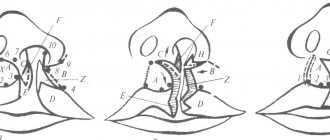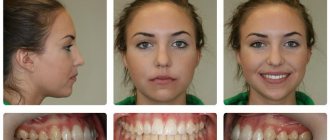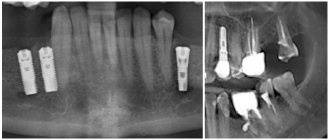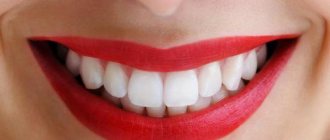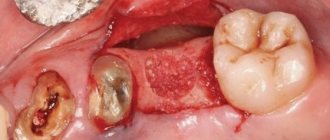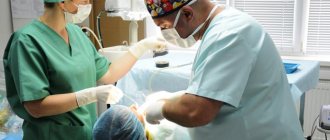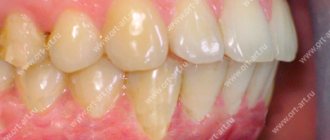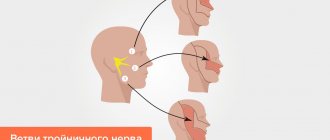There are cases when it is not possible to correct a malocclusion using braces and aligners, when it is not the pathological location of the teeth, but skeletal disorders in the jaws. Such as mesial or distal bite, when the lower jaw is located in front of the upper jaw or vice versa. In such situations, it is impossible to correct the bite using a conservative method. We resort to radical surgery to correct the bite - we correct the bite surgically, thereby lengthening or shortening the jaws and chin. Such operations can improve the profile of the face, make it more symmetrical and, as a fact, more attractive.
It should be clarified that operations to correct the bite are carried out during the period of completion of the formation of the jaws. Until the age of 18, the need for surgical intervention is decided strictly on an individual basis. Such operations are carried out if there are very serious deviations that are not amenable to other types of treatment.
In old age, these surgical interventions are recommended to be performed up to 60 years of age. If the patient is older, then the need for surgical intervention is decided individually, taking into account concomitant diseases.
In Krasnodar, surgical interventions to correct bites are carried out in many specialized clinics and hospitals.
How is a bite corrected surgically?
What is surgical orthodontics and when is it performed?
Radical surgical orthodontics is used to correct the bite when a change in the position of the teeth will lead to a deterioration in the patient’s condition, increased muscle tone, and, as a consequence, neurological disorders. With a mesial position of the lower jaw, or with its distal position, with pathological asymmetry of the face, when as a result of this the quality of life changes.
When a patient has a diction disorder that qualitatively disrupts his social life and alternative treatment does not lead to results, radical surgery is resorted to.
This manipulation is not performed in our clinic for a number of blood pathologies, for hormonal diseases, for immunodeficiencies, for children under 18 years of age, for diseases of a psychological nature.
The procedure itself is a surgical intervention into bone tissue. This manipulation is called osteotomy. The surgeon augments the bone or reduces its volume, makes an incision in the jaw, and can change the shape of the chin.
Types of operations to correct bite
Orthognathic operations are divided into several types. The doctor independently determines which of the possible options to use for a particular patient, based on the severity of the defects and other factors. Types of operations:
- Aesthetic genioplasty. The specialist’s task is to eliminate the patient’s facial asymmetry.
- Osteotomy of the upper jaw. The surgeon makes incisions behind the patient's eye sockets. After this, he places the upper jaw in the correct position and fixes it with the help of specialized splints.
- Osteotomy of the lower jaw. The doctor makes an incision in the lower jaw in the area behind the teeth. After placing the lower jaw in the correct position, the surgeon fixes it with titanium plates.
Indications for surgery
Today, patients themselves can insist on orthodontic surgery, or the doctor insists on this type of surgical intervention.
Indications for radical surgery to correct the bite are:
- significant underdevelopment of the lower jaw, or an upper jaw that is too forward
- if the teeth do not close in the lateral or anterior sections, the so-called open bite, which interferes with normal chewing of food
- if there are abnormalities in the development of the chin
- when the patient has significant diction problems
- if the patient received injuries that led to jaw deformities.
Indications and contraindications
Surgery to correct malocclusion is indicated for patients who have complaints of:
- swallowing disorder;
- problems with biting and chewing food;
- violation of diction;
- lip failure;
- protrusion and retraction of the lower jaw.
Facial plastic surgery is performed by an oral and maxillofacial surgeon for patients with any type of malocclusion:
- Distal bite. Patients are characterized by the following features: a lower jaw of normal or reduced size combined with an abnormal position of the upper jaw. With a distal bite, the patient's lips do not close and he experiences difficulty chewing food. Pathology significantly distorts the appearance of the face. Surgical method is the main method of treating malocclusion. The age of the patient is a contraindication: surgical intervention is not recommended before the age of 18, since the natural processes of growth and development of the skull bones can distort the result obtained or provoke a recurrence of the anomaly.
- Mesial bite. This diagnosis is characterized by protrusion of the lower jaw forward. In addition to the external defect, people with mesial occlusion have problems with diction and normal food intake. For mesial occlusion, surgical treatment is indicated.
- Deep bite. With such an anomaly, the teeth of the upper row cover the lower ones by more than a third of the height. A deep bite has an extremely negative effect on the health of teeth: uneven distribution of the load provokes abrasion, destruction and various diseases.
- Narrowing of the upper jaw. Underdevelopment of the upper jaw causes pain in the joints, and also severely crooks the dentition due to the lack of space necessary for the outer teeth. A narrowing of the upper jaw can be corrected without surgery if the patient is under 18 years of age. The orthodontist installs a special spacer on the upper jaw to eliminate the defect. For older people, surgical correction of the bite is indicated.
- Crossbite. Often, patients with the anomaly have distorted facial proportions. Asymmetry is caused by improper closure of the dentition: on one or two sides, the teeth of the lower dentition overlap the upper ones. The defect is congenital and is associated with anomalies in the proportion between the jaws: the upper is narrower than the lower.
Contraindications for the procedure are:
- blood pathologies associated with coagulation disorders;
- infections;
- inflammatory processes in the body;
- diabetes;
- nervous system disorders.
The decision to undergo jaw surgery is a serious step that requires lengthy preparation, significant financial costs and a difficult recovery period. It is important to conduct a detailed examination and consult with an orthodontist and surgeon before agreeing to surgery. If, after evaluating and comparing all the pros and cons, a decision is made to correct the bite surgically, the patient can rest assured that he will forever say goodbye to the problems of dental anomalies and return to a full-fledged lifestyle.
Preparation
Preparation for the operation to correct the bite is carefully carried out by our doctors; all plaque and tartar are removed; for this, a qualified hygienist will perform a series of manipulations to remove supragingival and subgingival deposits.
A general practitioner and a surgeon will treat caries and its complications, and remove teeth that have been destroyed at the root. In our clinic you can undergo all the necessary examinations before surgery and have a computed tomogram done on the latest tomograph. The dentist-surgeon together with the orthodontist will plan the future result and make a template.
Types of malocclusion
The mutual position of the teeth of the upper and lower jaws when they are closed, or the bite, normally has an even, symmetrical appearance, as well as a tight closure along the entire arch. In this case, the upper central incisors overlap the lower ones by approximately one-third of the height. The correct bite is called orthognathic . With pathological development, the bite takes on a characteristic appearance according to one of the following types:
- distal - the upper jaw protrudes forward and overlaps the lower jaw more strongly than expected;
- mesial - the lower jaw is pushed forward, the teeth form a reverse overlap;
- deep - the teeth of the upper jaw overlap the lower ones by half their height or more, forming a large sagittal gap (the distance between the teeth of the two jaws);
- open - when some teeth are closed, there is a gap between them; the upper and lower incisors or lateral teeth may not be in contact.
- cross - displacement (crossing) of the teeth of the upper and lower rows in the transverse direction;
Progress of the operation
Surgical correction of the bite is carried out in our clinic under general anesthesia under the guidance of an experienced chief physician and anesthesiologist-resuscitator and orthodontist. The duration can take from 15 minutes to 4 hours in complex cases. The operation itself includes the surgical stage itself, when access to the bone is carried out surgically through soft tissue in order to correct its position. The surgeon performs manipulations to reduce or increase the volume of bone tissue, or to displace it using a special surgical set and elements for fixing the bone (various splints, screws).
If the patient’s condition allows and there is a need, braces are installed immediately after surgery. After surgery, a fixing bandage is applied to the face. Sutures are placed on soft tissues, and the wound surface is treated.
In complex clinical cases, due to the proximity of other organs to the operated area, we involve the appropriate specialists - ophthalmologists, plastic surgeons, otorhinolaryngologists.
Since the operation is performed exclusively under general anesthesia, it is painless for the patient, under constant monitoring of the condition of vital organs and systems by an anesthesiologist.
What can a doctor do during surgery?
- remove the lower jaw and move it to a new place,
- break the jaw, remove part of the bone or, on the contrary, supplement it with the necessary segment,
- make an incision on the chin, remove part of the bone or build it up, giving a new shape to the lower part of the face,
- install a metal device that will increase the volume of bone tissue after its preliminary fracture.
Various instruments come to the aid of the surgeon: metal screws, plates and dictators - devices that create the necessary traction on the bone, allowing you to change its shape and thereby the position and size of the jaw.
Recovery period
The recovery stage after surgery is the longest. Since maxillofacial surgery, which is performed to restore malocclusions and straighten teeth, with distal occlusion in adults, the jaw often has to be broken, which is a complex surgery, and the recovery process in such patients takes longer and is quite painful.
In the postoperative period, there may be an increase in temperature, pain, and swelling of the face. It is important to strictly follow the recommendations that the surgeon gives after the operation.
The doctor will prescribe you a number of medications, give you all recommendations on nutrition, hygiene, and prescribe follow-up examinations and suture removal.
The healing period depends on the extent of the intervention and, as a rule, lasts from several weeks to 2 months.
Our specialists are in touch with patients around the clock, which allows us to reduce postoperative complications to zero.
Modern methods of correcting bites in adults
After 20 years, the jaw bones are already fully formed, and the teeth are in their places. It is useless to expect that everything will correct itself and the anomaly will resolve; it is necessary to begin correction with the correct equipment. Braces are considered the fundamental method of bite correction in adults.
Also, to correct malocclusion in adults, the following are used:
- specialized mouthguards, overlays (trainers and aligners);
- orthodontic plates.
In case of severe pathologies, surgery cannot be avoided. A long rehabilitation period will be required, but sometimes without a surgeon, complete bite correction will not be performed.
At Implantmaster, to determine the severity of the pathology and select the necessary equipment, Rg diagnostics are performed (panoramic image (OPTG) and teleroentgenogram (TRG)).
Next, we will talk about each method in more detail.
Correcting overbite with braces
Braces are miniature plates that are held on the tooth enamel using specialized glue. They are connected to each other by an arc made of a metal alloy, which exerts pressure on the units, causing them to move into the correct position.
Bite correction with a brace system is the main orthodontic technique used in all age categories of patients in the absence of restrictions. Using such small plates, in 1.5-3 years it is possible to fully correct bite pathology and create a beautiful smile.
Mechanics of operation of bracket systems . The arc, fixed in the locks of the plates, has “shape memory”. It is inserted into braces on all units, even taking into account their incorrect position. The arch puts mechanical pressure on the teeth and tries to return to its original shape, moving the units to the required place. Thus, the majority of jaw anomalies are corrected.
Types of plates. Orthodontic bracket systems differ in how the arch is secured in the groove of the plate, where they are attached and what material they are made of.
According to the method of fixing the arc:
- Ligature. The arch is attached to the bracket plate with special rubber bands or wires (ligatures).
- Self-ligating. Each plate has a locking lock that can be opened and closed with a special tool.
According to the tooth surface on which the plates are attached, the systems are:
- Vestibular. The system is installed on the outer (visible) surface of the units. When talking and smiling, the entire structure is visible.
- Lingual. They are located on the lingual surface of the enamel and are not visible when opening the mouth. However, they cause more discomfort while wearing and affect diction. Such a system is very difficult to clean, and it is much more expensive than other designs.
Material:
- Metal. They are attractive in cost, but are very noticeable on the enamel and can cause allergic reactions. However, such a system is very effective in treating the most severe malocclusion pathologies. At Implantmaster, specialists use a self-ligating system made of metal from the Damon model range. Correction of deep bites in adults using a metal system is effective.
- Gold. Gold plating is applied to the metal, which minimizes the likelihood of allergies and improves the aesthetics of the equipment.
- Plastic. Transparent and invisible on the enamel for the first months of wear, but then they absorb all the coloring pigments. The low cost of the system is attractive.
- Ceramic. They match the natural shade of the enamel, which is why they are not very visible on the teeth. Durable and comfortable, but expensive compared to other systems. For an aesthetic appearance of the smile area, Implantmaster doctors can recommend the Damon Clear ceramic self-ligating system.
- Sapphire. More transparent and stain resistant than ceramic. They look natural on the teeth.
The material of the system should be selected according to the appropriate cost and the required level of aesthetics, based on the recommendations of a specialist, taking into account your clinical situation.
The benefits of wearing braces . This is a classic, improved technique for correcting occlusion, which has various variations of installation and materials.
Positive aspects of treatment with braces:
- quick time to achieve results;
- cope with a wide variety of and most severe jaw pathologies;
- are installed for patients of any age;
The disadvantages include the presence of restrictions on use:
- lung diseases, diabetes mellitus, immunodeficiency states, cancer;
- drug addiction;
- diseases of the nervous system;
- It is necessary to be able to carefully and always perform oral hygiene.
Also, after fixing the system, you should get used to the fact that:
- the equipment will be visible to others;
- possible damage to the mucous membranes of the cheeks, gums, and tongue;
- oral hygiene will be difficult and needed much more often;
- you will need to reconsider your diet;
- At first, diction will be impaired.
The cost of a course of therapy when choosing inexpensive designs will be a plus, but when choosing an expensive system, it will become a minus.
When correcting a bite with braces in adults, prices directly depend on the material of the plates and the enamel surface for fixation. Also, each clinic will have its own pricing policy.
A ligation system may be less expensive, but will require more visits to a specialist, while a self-ligation system may be more expensive, but will require fewer visits. It is important to take this information into account when paying - pay a fixed cost at once, or you need to pay for the system and all manipulations separately.
Before and after results
Results before and after surgery will vary significantly. Depending on the scope of the surgical intervention, the type of pathology or injury, it depends on when the first results of the operation can be seen.
If the surgical intervention was extensive, screws, screws, pins were installed, then the result can be seen in a couple of months. The patient undergoes CT and TRG to assess changes in jaw position.
If screw fastenings were used during the operation, they are removed after 3-4 months, after which the result of the surgical treatment is finally assessed.
The final result of the operation depends both on the professionalism of the surgeon and on the patient’s compliance with all the doctor’s recommendations. The correct behavior of the patient during the rehabilitation period affects the final result of the surgical intervention.
How much does orthognathic surgery cost in Krasnodar?
The cost of the operation includes the operation itself and the post-operative period.
Orthognathic surgery without a postoperative period costs about 200 thousand rubles. The postoperative period will cost about 100 thousand rubles.
Patients in most cases are satisfied with the surgical intervention. They note an improvement in their quality of life. But for some, the disadvantage of this type of operation is the high cost. Since this type of operation is a planned operation of moderate severity, it is possible to carry it out under compulsory medical insurance. The waiting period can be more than 6 months.
